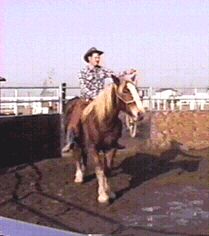|
Before starting this section you should decide whether you as the
handler are interested in domination or leadership. Domination is the
process of ruling by control or superior power and is often closely
associated with such terms as harshness, arrogance and tyranny. People
dominate horses all the time, but in most cases the horse isn't offering
a great deal of his own willingness and enthusiasm in return.
Leadership is more closely associated with a "head individual" or
"guiding hand." To the horse, the leader is whom nature has programmed to follow,
to pay attention to, and from whom he derives a general feeling of security.
Without the balls and chains of fear and repression that accompany
domination, leadership allows more of the horse's mental capacity to be used for learning and response. Many roadblocks and detours are removed and the horse develops more
clear and relaxed associations between the handlers cues and what needs to
be learned.
Set yourself up as a leader and the horse will follow. Set
yourself up as a leader and the horse will be a curious and attentive
student. Set yourself up as a leader who also gives clear and consistent
aids, and the horse will learn more quickly than one would imagine.
In the first part of this feature we touched on how a dominant horse will approach the
newcomer to a herd. This is but the first of a series of assimilation
encounters which in the wild might take up to several days. We can
duplicate this ritual in the round corral and because of the physical dynamics of
the pen, we can compress the ritual time down from days to literally
minutes.
In a nutshell, here's what happens in horse herds. (If you want to see
this for yourself, place a newcomer into a pasture which contains an established
group of horses.)
|
The new horse arrives and a dominant horse appears and says "Hi! I'm
dominant and you're going to take notice of me."
Unless the newcomer is the all-time-aggressive horse from Hell, he's
going to yield from the more dominant horse and say, "OK, I'm not going to
challenge you." (At this point the dominant horse will attempt to keep the
newcomer separate from the herd until the newcomer's relative ranking is
established.)
|
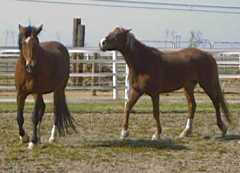
|
|
Within a short period of time the dominant horse will say, "OK, Newbee,
lets see how you can run!" The newcomer will run and the dominant horse
sizes up the newcomer's ability.
|
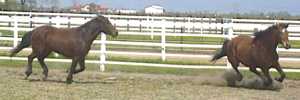
|
The dominant horse will then go through a series of maneuvers with the
newcomer whereupon the dominant one displays his physical prowess; his
ability to outmaneuver and "sort" the newcomer, causing Newbee to halt,
yield, turn, back and go forward at the dominant horse's will. One might argue that this is in
fact domination. We would counter that in this situation, the newcomer is
free to leave at any time and seek out another herd if the intensity of the
"welcoming committee" is greater than he can handle.
The physical arrangement of the round corral allows us to be in the
center where we hardly have to move at all in order to keep up with the
horse while the horse moves out at the circumference where there is much
work to be done. Aside from the fact that round corrals don't let horses
dive into and out of square corners, they make us appear to the horse as
swift and capable athletes who are owed respect.
On the negative side, the round corral doesn't allow the horse to leave if the pressure gets too great, so we have an obligation to manage the horse's stress level when in our presence. (Please see Why Horses Blow Up.)
There are several schools of thought with respect to round penning,
which range from "Go out and chase the poor beggar like the dominant horse does"
to "You should work with as little energy as it would take for the horse to
stay along the edge of the round pen if you had nothing more than a circle of string to contain him."
There is a place for both ends of this spectrum. With a dangerously
aggressive horse or one which is committed to "tuning out" humans, we'll
definitely be quite assertive and "turn up the volume," sometimes throwing
ropes, aggressively using "flags," etc. With nervous horses or ferals, we
have found it much more effective to use the least amount of
pressure that the horse will respond to. Being a new arrival the horse is already pretty sensitive and is wanting to assimilate into his new environment. (The
new arrival's "attitude" is why we'll usually start working with the horse
the first or second day he is on the ranch. It can literally take weeks off the
training process because Mother Nature is telling him, "Pay attention and
learn how to get along!")
Assuming we're not talking about overly docile or aggressive horses,
here's a typical round corral encounter.
|
We "approach and retreat" and meander about the pen until the horse is willing to accept our presence and faces us. (We're not here to use the round pen simply to chase or scare the horse. This is an interactive exercise.)
(See Catching Difficult
Horses for details as to how this is accomplished.)
|
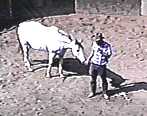
|
|
We try to encourage the horse to assume a relaxed posture so long as the horse is displaying non-aggressive, curious and/or submissive behavior.
We will accomplish this objective by setting up some mild "learn-learn" situations where
the most relaxing point in the arena is facing up to us or is near to us. If the horse shows any aggression we will "guard our space" as a sign we won't be intimidated and
to maintain a measure of safety.
|
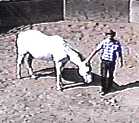
|
|
Next we will ask the horse to move off.
This can be done in various ways. Sharon
prefers to stay in the dead center of the round corral and let a "flag" or a longe
whip "do the talking." By this I mean she directs energy toward the horse
using the aid but she never strikes the horse. We call this the "indirect method" of
communication and it certainly has its place as the horse needs to learn to
listen to the various aids which we will be using.
|
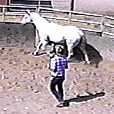
|
I prefer the "direct" method of walking "with" the horse, staying in a small
circle in the middle of the ring. I direct my energy behind the shoulder, oftentimes
twirling a short rope if the horse disregards my movements, and the horse thinks I'm walking with him. For me this method works best since the horse will be outside the round corral sooner or later and if I have to catch him, I want him to think I'm the better athlete and I don't want him to consider the option of running away.
|
We always reinforce our training by occasionally applying "the draw" as we go. In this maneuver we watch the horse as he is moving and at a moment where his attention is squarely on us, we will signal him to stop by applying slight pressure in front of the shoulder, but before the horse senses enough pressure that he rolls away from us we immediately step backwards at about a 30 to 45 degree angle behind the shoulder. If done correctly, the horse will turn and approach us.
(Horses may move away from pressure, but they learn at the point of release of pressure. Therefore it is important for the trainer to observe the horse and consistently release pressure at the point the horse makes the correct decision.)
|
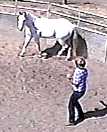
|
We can then expand on the draw, directing the horse past us and off into the
reverse direction. We much prefer having the horse face us in making a reverse rather than turn his butt toward us. We randomly mix draws and draw-reverses so that the horse doesn't get in the habit of always coming in on us or always reversing and taking off when we first ask him to draw. (Note: watch your spacing here if you are "direct communicating." The photo here is misleading. I always stay at least "a kick away" when setting up these kinds of maneuvers!)
|
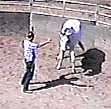
|
|
Once the horse has turned, we "guide him forward" by gesturing with our "lead hand" (the right one, in this instance) and applying pressure with our energy or aid with our "following hand" (the left one, in this instance). The horse should return to the rail and travel in the reverse direction. We have now established that we can stop, turn and send the horse away. This activity should be conducted quietly and thoughtfully.
|

|
|
Once we have established that we can direct the horse's movements at the walk, this methodology will work at
all gaits. In the photo the horse is galloping to the left and he is coming to a skid stop simply
because I have stepped in front of his shoulder (the drive line) and exerted some energy with two fingers. The amount
amount of energy applied will result in everything from a slight downward transition to a "skid-stop-roll-and-go." (Please note that this is an advanced move for experienced handlers and horses!)
|
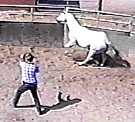
|
|
Have I terrified the horse? Well, right after the skid stop, I rolled the horse towards me and he's now following me at will at a trot.
Please note!!! Working "at speed" with one's back to the horse
this way can be dangerous for the handler until he is used to maintaining an awareness as to where the horse is at all times and knows how to effectively "wave the horse off" if things get too intense!
|
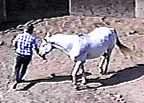
|
|
Please also note that we spend a great deal of time bonding with the animals we work with so their perspective during training is that of responding to the directions of another being in their social order, not being simply chased or harassed by a human predator!
|
Partnership: Wild horse off the range less than 7 months, riding among wild horses with no bridle.
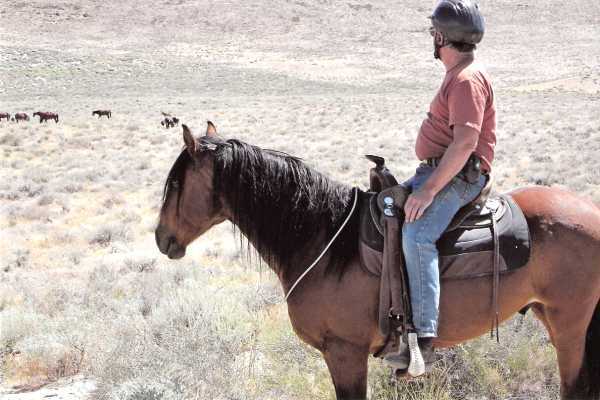
Coming up next: Converting round corral performance to practical uses.
Please also see Understanding the Lick / Chew Reflex.
Return to Part 1
Press Back to return to the page which brought you here
KBR Horse Training Information, © 1997 Lamm's Kickin' Back
Ranch and Willis & Sharon Lamm. All rights reserved. Duplication of any of this material for
commercial use is prohibited without express written permission. This prohibition is
not intended to extend to personal non-commercial use, including sharing with others for
safety and learning purposes, provided this copyright notice is attached.
Email us to submit comments or request reproduction
permission.
|

